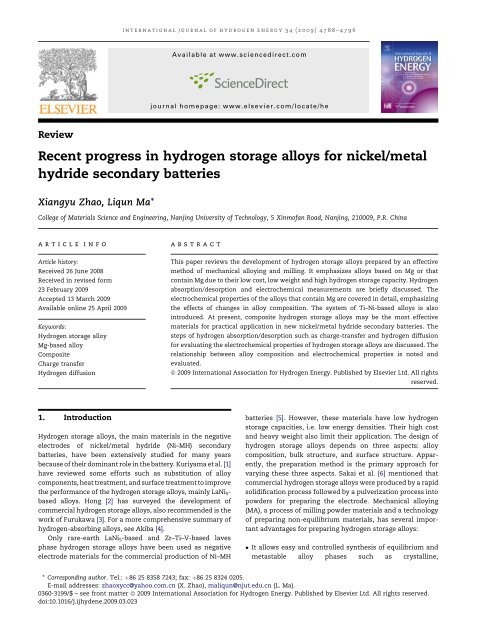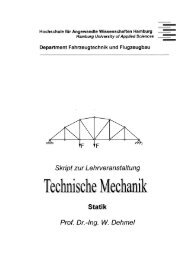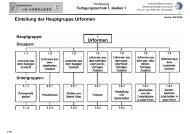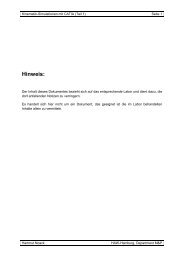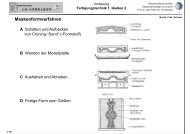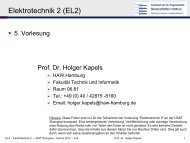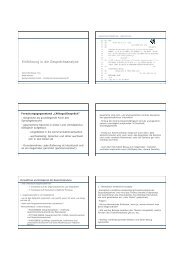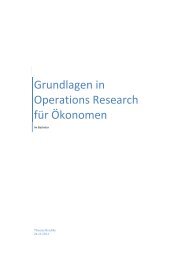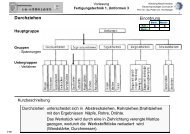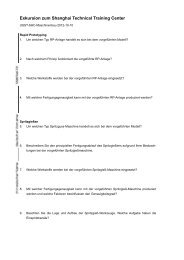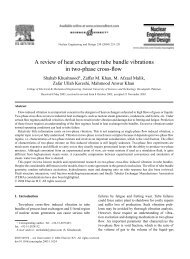Recent progress in hydrogen storage alloys for nickel/metal hydride ...
Recent progress in hydrogen storage alloys for nickel/metal hydride ...
Recent progress in hydrogen storage alloys for nickel/metal hydride ...
You also want an ePaper? Increase the reach of your titles
YUMPU automatically turns print PDFs into web optimized ePapers that Google loves.
Review<br />
<strong>Recent</strong> <strong>progress</strong> <strong>in</strong> <strong>hydrogen</strong> <strong>storage</strong> <strong>alloys</strong> <strong>for</strong> <strong>nickel</strong>/<strong>metal</strong><br />
<strong>hydride</strong> secondary batteries<br />
Xiangyu Zhao, Liqun Ma*<br />
College of Materials Science and Eng<strong>in</strong>eer<strong>in</strong>g, Nanj<strong>in</strong>g University of Technology, 5 X<strong>in</strong>mofan Road, Nanj<strong>in</strong>g, 210009, P.R. Ch<strong>in</strong>a<br />
article <strong>in</strong>fo<br />
Article history:<br />
Received 26 June 2008<br />
Received <strong>in</strong> revised <strong>for</strong>m<br />
23 February 2009<br />
Accepted 13 March 2009<br />
Available onl<strong>in</strong>e 25 April 2009<br />
Keywords:<br />
Hydrogen <strong>storage</strong> alloy<br />
Mg-based alloy<br />
Composite<br />
Charge transfer<br />
Hydrogen diffusion<br />
1. Introduction<br />
<strong>in</strong>ternational journal of <strong>hydrogen</strong> energy 34 (2009) 4788–4796<br />
abstract<br />
Hydrogen <strong>storage</strong> <strong>alloys</strong>, the ma<strong>in</strong> materials <strong>in</strong> the negative<br />
electrodes of <strong>nickel</strong>/<strong>metal</strong> <strong>hydride</strong> (Ni–MH) secondary<br />
batteries, have been extensively studied <strong>for</strong> many years<br />
because of their dom<strong>in</strong>ant role <strong>in</strong> the battery. Kuriyama et al. [1]<br />
have reviewed some ef<strong>for</strong>ts such as substitution of alloy<br />
components, heat treatment, and surface treatment to improve<br />
the per<strong>for</strong>mance of the <strong>hydrogen</strong> <strong>storage</strong> <strong>alloys</strong>, ma<strong>in</strong>ly LaNi5based<br />
<strong>alloys</strong>. Hong [2] has surveyed the development of<br />
commercial <strong>hydrogen</strong> <strong>storage</strong> <strong>alloys</strong>, also recommended is the<br />
work of Furukawa [3]. For a more comprehensive summary of<br />
<strong>hydrogen</strong>-absorb<strong>in</strong>g <strong>alloys</strong>, see Akiba [4].<br />
Only rare-earth LaNi 5-based and Zr–Ti–V-based laves<br />
phase <strong>hydrogen</strong> <strong>storage</strong> <strong>alloys</strong> have been used as negative<br />
electrode materials <strong>for</strong> the commercial production of Ni–MH<br />
Available at www.sciencedirect.com<br />
journal homepage: www.elsevier.com/locate/he<br />
This paper reviews the development of <strong>hydrogen</strong> <strong>storage</strong> <strong>alloys</strong> prepared by an effective<br />
method of mechanical alloy<strong>in</strong>g and mill<strong>in</strong>g. It emphasizes <strong>alloys</strong> based on Mg or that<br />
conta<strong>in</strong> Mg due to their low cost, low weight and high <strong>hydrogen</strong> <strong>storage</strong> capacity. Hydrogen<br />
absorption/desorption and electrochemical measurements are briefly discussed. The<br />
electrochemical properties of the <strong>alloys</strong> that conta<strong>in</strong> Mg are covered <strong>in</strong> detail, emphasiz<strong>in</strong>g<br />
the effects of changes <strong>in</strong> alloy composition. The system of Ti–Ni-based <strong>alloys</strong> is also<br />
<strong>in</strong>troduced. At present, composite <strong>hydrogen</strong> <strong>storage</strong> <strong>alloys</strong> may be the most effective<br />
materials <strong>for</strong> practical application <strong>in</strong> new <strong>nickel</strong>/<strong>metal</strong> <strong>hydride</strong> secondary batteries. The<br />
steps of <strong>hydrogen</strong> absorption/desorption such as charge-transfer and <strong>hydrogen</strong> diffusion<br />
<strong>for</strong> evaluat<strong>in</strong>g the electrochemical properties of <strong>hydrogen</strong> <strong>storage</strong> <strong>alloys</strong> are discussed. The<br />
relationship between alloy composition and electrochemical properties is noted and<br />
evaluated.<br />
ª 2009 International Association <strong>for</strong> Hydrogen Energy. Published by Elsevier Ltd. All rights<br />
reserved.<br />
batteries [5]. However, these materials have low <strong>hydrogen</strong><br />
<strong>storage</strong> capacities, i.e. low energy densities. Their high cost<br />
and heavy weight also limit their application. The design of<br />
<strong>hydrogen</strong> <strong>storage</strong> <strong>alloys</strong> depends on three aspects: alloy<br />
composition, bulk structure, and surface structure. Apparently,<br />
the preparation method is the primary approach <strong>for</strong><br />
vary<strong>in</strong>g these three aspects. Sakai et al. [6] mentioned that<br />
commercial <strong>hydrogen</strong> <strong>storage</strong> <strong>alloys</strong> were produced by a rapid<br />
solidification process followed by a pulverization process <strong>in</strong>to<br />
powders <strong>for</strong> prepar<strong>in</strong>g the electrode. Mechanical alloy<strong>in</strong>g<br />
(MA), a process of mill<strong>in</strong>g powder materials and a technology<br />
of prepar<strong>in</strong>g non-equilibrium materials, has several important<br />
advantages <strong>for</strong> prepar<strong>in</strong>g <strong>hydrogen</strong> <strong>storage</strong> <strong>alloys</strong>:<br />
It allows easy and controlled synthesis of equilibrium and<br />
metastable alloy phases such as crystall<strong>in</strong>e,<br />
* Correspond<strong>in</strong>g author. Tel.: þ86 25 8358 7243; fax: þ86 25 8324 0205.<br />
E-mail addresses: zhaoxycc@yahoo.com.cn (X. Zhao), maliqun@njut.edu.cn (L. Ma).<br />
0360-3199/$ – see front matter ª 2009 International Association <strong>for</strong> Hydrogen Energy. Published by Elsevier Ltd. All rights reserved.<br />
doi:10.1016/j.ijhydene.2009.03.023
nanocrystall<strong>in</strong>e, amorphous, and quasicrystall<strong>in</strong>e <strong>in</strong> spite of<br />
large differences <strong>in</strong> the melt<strong>in</strong>g po<strong>in</strong>ts of the raw materials.<br />
It can effectively synthesize a composite <strong>hydrogen</strong> <strong>storage</strong><br />
material which conta<strong>in</strong>s two or more <strong>hydrogen</strong> <strong>storage</strong> <strong>alloys</strong>.<br />
Its product is a powder which can be used directly <strong>for</strong><br />
<strong>hydrogen</strong> <strong>storage</strong> materials without subsequent size<br />
reduction.<br />
It is a simple and <strong>in</strong>expensive process<strong>in</strong>g technology operat<strong>in</strong>g<br />
at room temperature.<br />
Suryanarayana [7] and El-Eskandarany [8] have published<br />
two classic texts on mechanical alloy<strong>in</strong>g and mill<strong>in</strong>g. Dur<strong>in</strong>g<br />
high energy mill<strong>in</strong>g the powder particles are repeatedly flattened,<br />
cold welded, fractured and rewelded. The typical<br />
morphology with a lamellar structure which is <strong>for</strong>med by the<br />
alternation of cold weld<strong>in</strong>g and fracture decreases the diffusion<br />
distance. Furthermore, the particles are heavily de<strong>for</strong>med,<br />
and a variety of crystal defects such as dislocations, vacancies,<br />
stack<strong>in</strong>g faults, and an <strong>in</strong>creased number of gra<strong>in</strong> boundaries,<br />
which can enhance the diffusivity of solute elements <strong>in</strong>to<br />
the matrix, result. Additionally, the slight rise <strong>in</strong> temperature<br />
dur<strong>in</strong>g mill<strong>in</strong>g, perhaps <strong>in</strong>clud<strong>in</strong>g local high temperatures,<br />
further aids the diffusion behavior, and as a result, true alloy<strong>in</strong>g<br />
takes place among the constituent elements.<br />
The classes of <strong>hydrogen</strong> <strong>storage</strong> <strong>alloys</strong> can be pr<strong>in</strong>cipally or<br />
conventionally classified as AB5-type <strong>alloys</strong>, AB3-type <strong>alloys</strong>,<br />
A2B7-type <strong>alloys</strong>, AB2-type <strong>alloys</strong>, AB-type <strong>alloys</strong>, Mg-based<br />
<strong>alloys</strong> and V-based solid solution <strong>alloys</strong>. For prepar<strong>in</strong>g<br />
<strong>hydrogen</strong> <strong>storage</strong> <strong>alloys</strong>, the application of MA and/or<br />
mechanical mill<strong>in</strong>g (MM) began <strong>in</strong> the 1980s when the Mg2Ni<br />
<strong>hydrogen</strong> <strong>storage</strong> alloy was fabricated [9], and s<strong>in</strong>ce then this<br />
technology <strong>for</strong> the study of <strong>hydrogen</strong> <strong>storage</strong> <strong>alloys</strong> has<br />
flourished worldwide. In this review, the electrochemical<br />
properties and the development of Mg-based, AB 3-type, A 2B 7type,<br />
AB-type <strong>alloys</strong>, and composite <strong>hydrogen</strong> <strong>storage</strong> <strong>alloys</strong><br />
that are prepared by mechanical alloy<strong>in</strong>g and mill<strong>in</strong>g will be<br />
<strong>in</strong>troduced and discussed.<br />
2. Steps of <strong>hydrogen</strong> absorption/desorption<br />
Ni–MH batteries conta<strong>in</strong> an electrochemical system <strong>in</strong>volv<strong>in</strong>g<br />
a <strong>hydrogen</strong> <strong>storage</strong> electrode and a Ni(OH) 2/NiOOH counter<br />
electrode. The <strong>hydrogen</strong> <strong>storage</strong> alloy plays a dom<strong>in</strong>ant role <strong>in</strong><br />
the power and service life of a Ni–MH battery and determ<strong>in</strong>es<br />
the electrochemical properties of the battery, and is there<strong>for</strong>e<br />
still a research topic of great <strong>in</strong>terest. The <strong>hydrogen</strong> evolution<br />
reaction (HER) <strong>for</strong> <strong>hydrogen</strong> <strong>storage</strong> <strong>alloys</strong> <strong>in</strong>volves the<br />
follow<strong>in</strong>g steps:<br />
M þ H2O þ e 4MHads þ OH (1)<br />
MHads4MHabs<br />
MHabs4MH<strong>hydride</strong><br />
2MHads4M þ H2<br />
<strong>in</strong>ternational journal of <strong>hydrogen</strong> energy 34 (2009) 4788–4796 4789<br />
MHads þ H2O þ e 4M þ H2 þ OH (5)<br />
(2)<br />
(3)<br />
(4)<br />
i.e., the steps of adsorption/desorption, surface penetration,<br />
<strong>hydrogen</strong> diffusion, and <strong>for</strong>mation/decomposition of <strong>metal</strong><br />
<strong>hydride</strong>. In the <strong>in</strong>itial step of the HER, the adsorption of<br />
<strong>hydrogen</strong> atoms occurs on the surface of a <strong>hydrogen</strong> <strong>storage</strong><br />
alloy by dissociation of water. These atoms can be absorbed to<br />
<strong>for</strong>m <strong>metal</strong> <strong>hydride</strong>, but can also comb<strong>in</strong>e together to produce<br />
<strong>hydrogen</strong> gas accord<strong>in</strong>g to the Tafel reaction Eq. (4) and the<br />
Heyrovsky reaction Eq. (5). These steps can be also effectively<br />
described <strong>in</strong> a charge/discharge curve <strong>for</strong> a <strong>hydrogen</strong> <strong>storage</strong><br />
alloy, as shown <strong>in</strong> Fig. 1. In stage OA, the potential of the<br />
electrode rapidly changes with time or <strong>hydrogen</strong> content. This<br />
stage is the <strong>for</strong>mation of a solid solution called the a-phase.<br />
After this stage, <strong>in</strong> the section AB, the potential rema<strong>in</strong>s<br />
constant as the <strong>hydrogen</strong> content <strong>in</strong>creases. This constant<br />
plateau region <strong>in</strong>dicates a <strong>progress</strong>ive conversion of the aphase<br />
to a <strong>metal</strong> <strong>hydride</strong> called the b-phase. Eventually the<br />
curve beg<strong>in</strong>s to slope aga<strong>in</strong>, <strong>in</strong>dicat<strong>in</strong>g that the conversion of<br />
a-phase to b-phase is f<strong>in</strong>ished. F<strong>in</strong>ally, with further <strong>in</strong>crease of<br />
the charg<strong>in</strong>g time, there is another plateau region which<br />
corresponds to the process of <strong>hydrogen</strong> evolution and <strong>in</strong>dicates<br />
that the charge of the electrode is saturated. Dur<strong>in</strong>g<br />
discharge, the b-phase decomposes to the a-phase, revers<strong>in</strong>g<br />
the charg<strong>in</strong>g process. It is obvious that the per<strong>for</strong>mance of the<br />
<strong>hydrogen</strong> <strong>storage</strong> alloy is determ<strong>in</strong>ed <strong>in</strong> the stage where the<br />
two phases coexist, i.e., the k<strong>in</strong>etics of the charge transfer<br />
reaction at the electrode surface, the rate of <strong>hydrogen</strong> transfer<br />
between the absorbed state and the adsorbed state, and the<br />
diffusion of absorbed <strong>hydrogen</strong> between the bulk and the<br />
electrode surface [10].<br />
Many ef<strong>for</strong>ts [11–17] have <strong>in</strong>vestigated the steps of<br />
<strong>hydrogen</strong> absorption/desorption, especially the chargetransfer<br />
reaction at the electrode/electrolyte <strong>in</strong>terface and<br />
<strong>hydrogen</strong> diffusion with<strong>in</strong> the bulk electrode. These are the<br />
two dom<strong>in</strong>ant factors, particularly <strong>for</strong> the high rate dischargeability<br />
(HRD) of <strong>hydrogen</strong> <strong>storage</strong> alloy electrodes<br />
[18–20]. The two steps can be expressed by the values of<br />
electrochemical k<strong>in</strong>etic parameters such as exchange current<br />
density, polarization resistance, and <strong>hydrogen</strong> diffusion<br />
coefficient.<br />
Potential (V)<br />
O<br />
A<br />
charge<br />
B<br />
C<br />
D<br />
Charge-discharge time (h)<br />
E<br />
discharge<br />
Fig. 1 – Schematic illustration of a charge–discharge curve<br />
<strong>for</strong> a <strong>hydrogen</strong> <strong>storage</strong> alloy.<br />
F<br />
G
4790<br />
The exchange current density of <strong>hydrogen</strong> <strong>storage</strong> alloy<br />
electrodes can be determ<strong>in</strong>ed by l<strong>in</strong>ear polarization [18,21],<br />
Tafel polarization [21,22], and electrochemical impedance<br />
spectroscopy (EIS) [22,23]. The exchange current density I0 can<br />
be obta<strong>in</strong>ed from a l<strong>in</strong>earized <strong>for</strong>m of the Butler–Volmer<br />
equation <strong>in</strong> the low overpotential region (h < 10 mV). The<br />
l<strong>in</strong>ear equation can be written as:<br />
I0 ¼ IRT<br />
(6)<br />
Fh<br />
where I is the applied current density, R is the gas constant, T<br />
is the absolute temperature, F is the Faraday constant, and h is<br />
the overpotential of the electrochemical reaction <strong>for</strong> the<br />
<strong>hydrogen</strong> <strong>storage</strong> <strong>alloys</strong>. The Tafel region is controlled by the<br />
step of charge transfer at high overpotential (h > 118 mV). For<br />
porous <strong>hydrogen</strong> <strong>storage</strong> alloy electrodes, the Tafel region<br />
shows strong mass-transfer effects at high currents. Us<strong>in</strong>g the<br />
measured limit<strong>in</strong>g current densities from the curve of Tafel<br />
polarization, the Tafel plots can be corrected <strong>for</strong> mass-transfer<br />
effects by plott<strong>in</strong>g the logarithm of I/(1 I/IL) aga<strong>in</strong>st the<br />
electrode potential, which can be expressed as:<br />
h ¼ 2:3RT<br />
bF log1 þ<br />
I0<br />
2:3RT<br />
bF log<br />
I<br />
1 I=IL<br />
where I L is the limit<strong>in</strong>g current density, and b is the transfer<br />
coefficient <strong>for</strong> <strong>hydrogen</strong> desorption. For EIS, the semicircle <strong>in</strong><br />
the high frequency region is related to the contact resistance<br />
between the current collector and the alloy pellet, and the<br />
semicircle <strong>in</strong> the low frequency region corresponds to the<br />
charge-transfer resistance Rct [23–25]. The exchange current<br />
density can be calculated us<strong>in</strong>g the follow<strong>in</strong>g Equation [21,26]:<br />
I0 ¼ RT<br />
F<br />
1<br />
Rct<br />
Ratnakumar et al. [22] and Witham et al. [27] found that<br />
exchange current densities estimated from l<strong>in</strong>ear polarization<br />
were <strong>in</strong> agreement with those from EIS, but were quite<br />
different from the values obta<strong>in</strong>ed from Tafel polarization.<br />
Wang et al. [10] proposed that this discrepancy may be caused<br />
by a neglect of the effect of <strong>hydrogen</strong> transfer between the<br />
absorbed and adsorbed states.<br />
Many approaches have been proposed <strong>for</strong> evaluat<strong>in</strong>g the<br />
<strong>hydrogen</strong> diffusion coefficient, <strong>in</strong>clud<strong>in</strong>g nuclear magnetic<br />
resonance [28], quasi-elastic neutron scatter<strong>in</strong>g [29], and<br />
various electrochemical technologies of current pulse [30],<br />
cyclic voltammetry [31], EIS [32], and potential-step [33,34].<br />
The potential-step method, a simple and convenient technology,<br />
is widely used to study the <strong>hydrogen</strong> diffusion coefficient.<br />
When a large potential-step is applied to <strong>hydrogen</strong><br />
<strong>storage</strong> alloy electrodes, a drastic depletion of <strong>hydrogen</strong><br />
occurs on the alloy surface. After a long response time, the<br />
current decreases slowly <strong>in</strong> a l<strong>in</strong>ear fashion. In this l<strong>in</strong>ear<br />
region, <strong>hydrogen</strong> diffusion controls the electrode process, and<br />
the <strong>hydrogen</strong> diffusion coefficient D can be calculated<br />
accord<strong>in</strong>g to the follow<strong>in</strong>g equation [20,33–35]:<br />
log i ¼ log 6FD<br />
da 2 ðC0 CsÞ<br />
<strong>in</strong>ternational journal of <strong>hydrogen</strong> energy 34 (2009) 4788–4796<br />
p2 D<br />
2:303 a2t where i (A/g) is the diffusion current density, D (cm 2 /s) is the<br />
<strong>hydrogen</strong> diffusion coefficient, d (g/cm 3 ) is the density of the<br />
(7)<br />
(8)<br />
(9)<br />
<strong>hydrogen</strong> <strong>storage</strong> alloy, a (cm) is the alloy particle radius, C 0<br />
(mol/cm 3 ) is the <strong>in</strong>itial <strong>hydrogen</strong> concentration <strong>in</strong> the bulk of<br />
the alloy, Cs (mol/cm 3 ) is the <strong>hydrogen</strong> concentration on the<br />
surface of the alloy particles and t (s) is the discharge time.<br />
This method needs a long time period, generally several<br />
thousand seconds, to measure the response of the anodic<br />
current. As a result, the calculated <strong>hydrogen</strong> diffusion coefficient<br />
will be an average value. Consequently, this method is<br />
unsuitable <strong>for</strong> determ<strong>in</strong><strong>in</strong>g the <strong>hydrogen</strong> diffusion coefficient<br />
at a certa<strong>in</strong> depth of discharge (DOD). Feng et al. [17,36]<br />
described a new and relatively simple potentiostatic method<br />
<strong>for</strong> determ<strong>in</strong><strong>in</strong>g the <strong>hydrogen</strong> diffusion coefficient over<br />
a small time period, less than 500 s. The <strong>hydrogen</strong> diffusion<br />
coefficient can be found by measur<strong>in</strong>g the ratio of <strong>in</strong>tercept<br />
and slope from a l<strong>in</strong>ear plot of I(t) versus t 1/2 by us<strong>in</strong>g the<br />
follow<strong>in</strong>g equation:<br />
IðtÞ ¼ FADðCs C0Þ<br />
1 1<br />
pffiffiffiffiffiffi<br />
pffiffit<br />
pD<br />
1<br />
a<br />
(10)<br />
where A is the surface area of the particles (m 2 /g). This<br />
method does not require knowledge of either the <strong>hydrogen</strong><br />
concentration or the surface area of the alloy particles. The<br />
<strong>hydrogen</strong> diffusion coefficient at a certa<strong>in</strong> DOD can be<br />
obta<strong>in</strong>ed by us<strong>in</strong>g this method.<br />
Apart from the steps of charge-transfer and <strong>hydrogen</strong><br />
diffusion, the process of <strong>hydrogen</strong> transfer, which was<br />
neglected <strong>in</strong> previous studies, is also discussed by Wang et al.<br />
[10] who assume that the pressure plateau of a <strong>hydrogen</strong><br />
<strong>storage</strong> alloy is flat and the fully charged <strong>hydride</strong> electrode is<br />
considered to be uni<strong>for</strong>mly discharged at each DOD.<br />
3. Mg-based <strong>alloys</strong><br />
Mg has a high reversible <strong>storage</strong> capacity of 7.6 wt.% (approx.<br />
2200 mAh/g) <strong>hydrogen</strong>, which is pr<strong>in</strong>ciple makes it a promis<strong>in</strong>g<br />
candidate as a <strong>storage</strong> medium <strong>in</strong> mobile applications. In<br />
recent years, more attention has been paid to develop<strong>in</strong>g<br />
applications of Mg-based <strong>alloys</strong> <strong>in</strong> Ni–MH secondary batteries<br />
because of their high <strong>storage</strong> capacity, low cost and low<br />
weight. MA is a simple and effective method <strong>for</strong> prepar<strong>in</strong>g Mgbased<br />
<strong>alloys</strong> with metastable or non-equilibrium phases,<br />
which do not appear <strong>in</strong> phase-diagrams, <strong>in</strong> spite of large<br />
differences <strong>in</strong> the melt<strong>in</strong>g po<strong>in</strong>ts of the raw materials. The<br />
alloy composition can be simply controlled. S<strong>in</strong>gh et al. [37]<br />
described a nanocrystall<strong>in</strong>e Mg2Ni alloy with a gra<strong>in</strong> size of<br />
about 4 nm <strong>for</strong>med after mill<strong>in</strong>g magnesium and <strong>nickel</strong><br />
powders. Amorphous Mg2Ni alloy can also be prepared by MA<br />
[38]. Cui et al. [39] showed that the <strong>for</strong>mation and growth of<br />
a magnesium oxide and/or hydroxide layer on Mg 2Ni<br />
<strong>in</strong>creased the electronic resistance at the electrode/electrolyte<br />
<strong>in</strong>terface and resulted <strong>in</strong> a large discharge overpotential,<br />
lead<strong>in</strong>g to low discharge capacity and sluggish k<strong>in</strong>etics of the<br />
alloy. In order to improve the electrochemical properties of<br />
Mg-based alloy, element substitution of Mg-based <strong>alloys</strong> has<br />
been extensively attempted. Although Zr [40], Ti[41], Co[42],<br />
Al [43],Ce[44], Y[45], Ca[46] and Fe [47] have been <strong>in</strong>troduced<br />
<strong>in</strong>to Mg2Ni alloy to improve their <strong>hydrogen</strong> absorption/<br />
desorption properties, there was no apparent improvement.
Liu et al. [48] described a composition of Mg 0.7Ti 0.225Al 0.075Ni<br />
which showed a low decay of discharge capacity due to the<br />
<strong>for</strong>mation of MgTi2O4 <strong>in</strong>stead of Mg(OH)2. A similar positive<br />
result was reported by Tian et al. [49] who found that<br />
a composition of Mg0.8Ti0.1Pd0.1Ni possessed good cycle<br />
stability because of a protective layer of (NiO)x(PdO)y(TiO2)z.<br />
Apart from element substitution, Rongeat et al. [50] proposed<br />
that an <strong>in</strong>crease of MgNi particle size could effectively<br />
improve the cycle stability and high rate dischargeability<br />
because larger particles had a lower sensitivity to oxidation.<br />
Then, a comprehensive work [51] that considered both<br />
element substitution and particle size showed that an amorphous<br />
Mg0.9Ti0.1NiAl0.05 alloy with particle size larger than<br />
150 mm displayed excellent electrochemical properties, as<br />
good as a commercial LaNi5-based alloy, due to a control of the<br />
charge <strong>in</strong>put and a cooperative protection by Ti and Al.<br />
Obviously the cost and weight are much lower than a LaNi5based<br />
alloy. However, the high rate dischargeability is presently<br />
too low, which will limit the potential use of Mg-based<br />
<strong>alloys</strong> <strong>in</strong> real applications; this should be studied further.<br />
4. AB 3- and A 2B 7-type <strong>alloys</strong><br />
AB3- and A2B7-type <strong>alloys</strong> have been studied <strong>for</strong> decades. Ivey<br />
et al. [52] reviewed b<strong>in</strong>ary <strong>alloys</strong> correlated to AB3 and A2B7<br />
<strong>alloys</strong>, and mentioned that the structures of AB3 and A2B7 can<br />
be related to those of AB5 and AB2. Based on the assumption<br />
that there are no long-range H–H <strong>in</strong>teractions, these relations<br />
can be expressed as [53]:<br />
nðAB3Þ ¼ 1 2<br />
nðAB5Þþ<br />
3 3 nðAB2Þ (11)<br />
and<br />
<strong>in</strong>ternational journal of <strong>hydrogen</strong> energy 34 (2009) 4788–4796 4791<br />
nðA2B7Þ ¼nðAB5ÞþnðAB2Þ (12)<br />
where n(AkBm) represent the <strong>hydrogen</strong> concentration <strong>for</strong> each<br />
of the respective <strong>for</strong>mula units. Zhang et al. [54] described the<br />
<strong>for</strong>mation of amorphous LaNi 2H x and LaNi 5H y after <strong>hydrogen</strong><br />
absorption by LaNi 3 at 298 K. The amorphous LaNi 2H x would<br />
decompose to LaH 2 and LaNi 5H z at 473 K. Similar results were<br />
reported by Srivastava [55] who also claimed that both LaNi 3<br />
and La2Ni7 had lower <strong>storage</strong> capacity than LaNi5 but better<br />
suppression of pulverization. In recent years, ternary or<br />
multiple AB3 and A2B7 <strong>alloys</strong> have been developed. Kadir et al.<br />
[56,57] reported a ternary system of R–Mg–Ni (R ¼ rare earth,<br />
Ca or Y) with a PuNi3-type rhombohedral structure, which was<br />
of great <strong>in</strong>terest <strong>for</strong> many researchers. Liang et al. [58] presented<br />
a mechanically alloyed Ca2Ni7, the structure of which<br />
could be destroyed by substitut<strong>in</strong>g Mg <strong>for</strong> a small fraction of<br />
the Ca, result<strong>in</strong>g <strong>in</strong> the <strong>for</strong>mation of an AB 3 phase with an<br />
accompany<strong>in</strong>g <strong>nickel</strong> phase, but the as-milled <strong>alloys</strong> absorbed<br />
<strong>hydrogen</strong> with poor reversibility. Ml (La-rich misch<strong>metal</strong>) can<br />
be effectively used <strong>for</strong> the A side [59]. The element Ni on the B<br />
side can be partially substituted by Co, Mn, Fe, Al and Cu to<br />
improve the k<strong>in</strong>etics and cycle stability [60,61]. For electrochemical<br />
properties, Zhang [62] fabricated a composition of<br />
La1.5Mg0.5Ni7 with a maximum discharge capacity of<br />
389.4 mAh/g, good activation characteristics and good cycle<br />
stability. Its HRD showed a high value of 92.3% at a current<br />
density of 900 mA/g. This year a new phase, MgNi 3, with the<br />
same cubic crystal lattice as AuCu3 has been reported [63].<br />
More work needs to be carried out with AB3- and A2B7-type<br />
<strong>alloys</strong>.<br />
5. AB-type <strong>alloys</strong><br />
Early work on AB-type <strong>hydrogen</strong> <strong>storage</strong> <strong>alloys</strong> was restricted<br />
to TiFe. There are two stable <strong>in</strong>ter<strong>metal</strong>lic compounds <strong>for</strong>med<br />
by the Ti–Fe system, TiFe and TiFe 2 [52]. The application of<br />
TiFe <strong>in</strong> Ni–MH batteries has been limited because of its poor<br />
k<strong>in</strong>etics of <strong>hydrogen</strong> absorption/desorption [64]. In recent<br />
years, more AB-type <strong>hydrogen</strong> <strong>storage</strong> <strong>alloys</strong> consist<strong>in</strong>g of Ti,<br />
Zr or Hf on the A side and Fe, Ni, Al, Co, Mn, or Sn on the B side<br />
have been <strong>in</strong>vestigated [65–69]. The substitution of Ni <strong>for</strong> Fe<br />
could improve the activation per<strong>for</strong>mance and discharge<br />
capacity. TiFe 0.25Ni 0.75 showed a high discharge capacity of<br />
155 mAh/g on the third cycle [67]. Although the Ti–Ni system<br />
has been studied <strong>for</strong> many years, it is still <strong>in</strong> an active research<br />
topic [70–73]. Cuevas et al. [74] have shown that martensitic<br />
Ti 0.64Zr 0.36Ni exhibited much higher reversible capacity, about<br />
330 mAh/g. Nevertheless, the electrochemical properties of<br />
this system of <strong>alloys</strong> are unsatisfactory [73].<br />
Ti–Ni-based <strong>alloys</strong> with a similar composition but a quasicrystall<strong>in</strong>e<br />
structure have been described <strong>in</strong> the past few years<br />
[75,76]. There are many <strong>in</strong>terstices which could be suitable<br />
sites <strong>for</strong> <strong>hydrogen</strong> atoms <strong>in</strong> a quasicrystall<strong>in</strong>e Ti–Zr–Ni alloy,<br />
compared to a normal crystal structure [76]. Liu et al. [26]<br />
found that Ti 45 xZr 35 xNi 17þ2xCu 3 icosahedral quasicrystall<strong>in</strong>e<br />
phase (I-phase) had a large discharge capacity of 269 mAh/g<br />
without <strong>in</strong>itial activation, when x was up to 8. Increased <strong>nickel</strong><br />
content improved the electrochemical k<strong>in</strong>etic properties and<br />
prevented oxidation of the alloy electrodes. The <strong>hydrogen</strong><br />
<strong>storage</strong> <strong>alloys</strong> with quasicrystall<strong>in</strong>e structure show good<br />
<strong>hydrogen</strong> <strong>storage</strong> properties. However, direct fabrication of<br />
this quasicrystall<strong>in</strong>e phase by MA has not been reported.<br />
Takasaki et al. [77] expla<strong>in</strong>ed that MA processes elemental<br />
powders mostly by dynamic <strong>for</strong>ce or mechanical collision,<br />
which leads to chemically <strong>in</strong>homogeneous f<strong>in</strong>al products and<br />
makes it difficult to produce a s<strong>in</strong>gle quasicrystall<strong>in</strong>e phase.<br />
6. Composite <strong>hydrogen</strong> <strong>storage</strong> <strong>alloys</strong><br />
Desirable electrochemical properties of <strong>hydrogen</strong> <strong>storage</strong><br />
<strong>alloys</strong> <strong>in</strong>clude high <strong>storage</strong> capacity, easy activation, high<br />
resistance to corrosion, favorable k<strong>in</strong>etic per<strong>for</strong>mance, high<br />
HRD, and low cost. In practice, it is difficult to simultaneously<br />
obta<strong>in</strong> all these properties <strong>in</strong> a s<strong>in</strong>gle alloy system, but us<strong>in</strong>g<br />
a composite <strong>hydrogen</strong> <strong>storage</strong> alloy is an effective way to<br />
achieve it. A composite <strong>hydrogen</strong> <strong>storage</strong> alloy conta<strong>in</strong>s two or<br />
more <strong>hydrogen</strong> <strong>storage</strong> <strong>alloys</strong>, or a <strong>hydrogen</strong> <strong>storage</strong> alloy and<br />
another <strong>in</strong>ter<strong>metal</strong>lic compound. Generally, the major<br />
component <strong>in</strong> a composite <strong>hydrogen</strong> <strong>storage</strong> alloy is an alloy<br />
with good <strong>hydrogen</strong> <strong>storage</strong> properties. The m<strong>in</strong>or component<br />
is a surface activator to improve the activation properties and<br />
the k<strong>in</strong>etics of <strong>hydrogen</strong> sorption/desorption [78].<br />
AB5- and AB2-type <strong>alloys</strong> are the two conventional<br />
<strong>hydrogen</strong> <strong>storage</strong> <strong>alloys</strong>. Each one has its own advantages,
4792<br />
<strong>in</strong>ternational journal of <strong>hydrogen</strong> energy 34 (2009) 4788–4796<br />
such as easy activation of AB 5 and high <strong>storage</strong> capacity of<br />
AB2. Chen et al. [79] milled an AB2 Zr–Ti–V–Ni alloy with added<br />
LaNi5, and showed that the matrix alloy was successfully<br />
coated with f<strong>in</strong>e nanocrystall<strong>in</strong>e LaNi5 and the electrochemical<br />
activation of the AB2 alloy was effectively improved.<br />
A similar result was obta<strong>in</strong>ed by Han et al. [80] who found that<br />
the addition of LaNi5 improved not only the activation<br />
per<strong>for</strong>mance but also the high rate dischargeability of the<br />
matrix due to a segregated La–Ni phase which provided active<br />
sites and pathways <strong>for</strong> <strong>hydrogen</strong> diffusion. Another <strong>in</strong>terest<strong>in</strong>g<br />
result was that the addition of AB 5 alloy could drastically<br />
decrease the amount of V dissolved from the matrix by<br />
the KOH electrolyte [81]. On the contrary, an AB2 alloy added to<br />
a matrix of LaNi5 alloy [82] enhanced the discharge capacity of<br />
the matrix.<br />
Yang et al. [78] found that amorphous Mg–Ni alloy can be<br />
an excellent surface activator to elim<strong>in</strong>ate the <strong>in</strong>itial activation<br />
and substantially improve the k<strong>in</strong>etic properties of <strong>alloys</strong><br />
such as Zr(Ni0.6Mn0.15Cr0.1V0.15)2 and ZrCrNi, which are usually<br />
considered unsuitable <strong>for</strong> practical application because of<br />
their poor k<strong>in</strong>etics and difficult activation. Choi et al. [83]<br />
demonstrated a similar result <strong>in</strong> a system of TiV 2.1Ni 0.3–MgNi<br />
composites, and expla<strong>in</strong>ed that the amorphous MgNi alloy not<br />
only acted as a protective film aga<strong>in</strong>st corrosion, but also<br />
<strong>for</strong>med a uni<strong>for</strong>m layer with high electrocatalytic per<strong>for</strong>mance<br />
and high elasticity on the surface of the matrix. It is<br />
well known that Mg-based <strong>alloys</strong> have attractively high<br />
<strong>storage</strong> capacity, low cost and light weight. Un<strong>for</strong>tunately,<br />
they have poor <strong>hydrogen</strong> absorption/desorption characteristics,<br />
which seriously blocks their practical use <strong>in</strong> energy<br />
<strong>storage</strong>. Cui et al. [84] <strong>in</strong>vestigated a composite alloy of Mg 2Ni–<br />
40 wt%Ti2Ni. The addition of Ti2Ni particles <strong>in</strong>laid on the<br />
surface of Mg2Ni particles improved both the charge-transfer<br />
reaction at the surface of alloy and <strong>hydrogen</strong> diffusion <strong>in</strong> the<br />
bulk alloy. Some <strong>in</strong>ter<strong>metal</strong>lic compounds such as CoB [85]<br />
and TiB [86] are also effective additions <strong>for</strong> prepar<strong>in</strong>g<br />
composite <strong>hydrogen</strong> <strong>storage</strong> <strong>alloys</strong>. In recent years, magnesium<br />
has been used as a substitutable element <strong>in</strong> the system<br />
of La–Mg–Ni <strong>alloys</strong> which were extensively studied as negative<br />
electrode candidates <strong>for</strong> Ni–MH secondary batteries due to<br />
their high discharge capacities [58–62]. However, the <strong>in</strong>ferior<br />
cycle durability of these <strong>alloys</strong> limits their real application.<br />
Prepar<strong>in</strong>g composite <strong>hydrogen</strong> <strong>storage</strong> <strong>alloys</strong> is also a good<br />
method to improve their overall properties [87–89].<br />
7. Electrochemical k<strong>in</strong>etics of <strong>hydrogen</strong><br />
absorption/desorption<br />
The thermodynamic properties of a <strong>metal</strong>-<strong>hydrogen</strong> system<br />
are conveniently summarized by a pressure–composition–<br />
temperature (PCT) curve [90]. Thermodynamic parameters<br />
such as the enthalpy DH and the entropy DS of <strong>hydride</strong><br />
<strong>for</strong>mation can be determ<strong>in</strong>ed from the Van’t Hoff equation<br />
[91].<br />
Apart from thermodynamic properties, another important<br />
criterion <strong>for</strong> a <strong>metal</strong>-<strong>hydrogen</strong> system is the electrochemical<br />
k<strong>in</strong>etics of <strong>hydrogen</strong> absorption/desorption, i.e. the k<strong>in</strong>etics<br />
of the charge-transfer reaction at the electrode/electrolyte<br />
<strong>in</strong>terface and <strong>hydrogen</strong> diffusion with<strong>in</strong> the bulk electrode.<br />
Table 1 – Exchange current densities <strong>for</strong> <strong>hydrogen</strong> <strong>storage</strong> <strong>alloys</strong> at 50% DOD.<br />
Composition Phase structure Exchange current<br />
density, I0 (mA/g)<br />
Reference<br />
Ti0.8Zr0.2V2.7Mn0.5Cr0.8Ni1.25 C14 Laves phase, V-based<br />
solid solution phase<br />
142.8 [93]<br />
Ti0.8Zr0.2V2.7Mn0.5Cr0.5Ni1.25Fe0.3 178.7 [93]<br />
Ti0.8Zr0.2V2.7Mn0.5Ni1.25Fe0.8 46.96 [93]<br />
Ti45Zr35Ni17Cu3 I-phase 199.5 [26]<br />
Ti43Zr33Ni21Cu3 229.1 [26]<br />
Ti41Zr31Ni25Cu3 301.2 [26]<br />
Ti37Zr27Ni33Cu3 480.7 [26]<br />
La2MgNi9 PuNi3-type 88.5 [60]<br />
La2Mg(Ni0.09Al0.01)9 65.4 [60]<br />
La2Mg(Ni0.08Al0.02) 9 62.8 [60]<br />
La1.7Mg0.3Ni7.0 LaNi5, PuNi3-type 128.1 [62]<br />
La1.6Mg0.4Ni7.0 228.7 [62]<br />
La1.5Mg0.5Ni7.0 227.7 [62]<br />
La1.4Mg0.6Ni7.0 167.3 [62]<br />
La0.7Mg0.3(Ni0.85Co0.15) 3 PuNi3-type 186.5 [19]<br />
La0.7Mg0.3(Ni0.85Co0.15)4 222.3 [19]<br />
La0.7Mg0.3(Ni0.85Co0.15)5 190.1 [19]<br />
Mg0.86Ti0.1Pd0.04Ni Amorphous 256 [49]<br />
Mg0.84Ti0.1Pd0.06Ni 247 [49]<br />
Mg0.8Ti0.1Pd0.1Ni 184 [49]<br />
La0.7Mg0.3Ni3.5 PuNi3-type, LaNi5 79.6 [89]<br />
Ti0.17Zr0.08V0.35Cr0.1Ni0.3 V-based solid solution phase, C14 Laves phase 99.5 [89]<br />
La0.7Mg0.3Ni3.5 þ 5 wt.% Ti0.17Zr0.08V0.35Cr0.1Ni0.3 PuNi3-type, LaNi5, V-based solid solution<br />
phase, C14 Laves phase<br />
362.9 [89]<br />
La 0.7Mg 0.3Ni 3.5 þ 50 wt.% Ti 0.17Zr 0.08V 0.35Cr 0.1Ni 0.3 201.6 [89]
<strong>in</strong>ternational journal of <strong>hydrogen</strong> energy 34 (2009) 4788–4796 4793<br />
These can be expressed by the values of the exchange<br />
current density I0 and/or the polarization resistance Rp, as<br />
well as the <strong>hydrogen</strong> diffusion coefficient D and/or diffusion<br />
resistance RD.<br />
Tables 1 and 2 summarize the I0 and D values of <strong>hydrogen</strong><br />
<strong>storage</strong> <strong>alloys</strong> <strong>in</strong> a half-cell conta<strong>in</strong><strong>in</strong>g a Ni(OH)2/NiOOH<br />
counter electrode and a Hg/HgO reference electrode <strong>in</strong> the<br />
KOH solution, respectively. Zheng et al. [18] have found that<br />
the exchange current density I 0 obta<strong>in</strong>ed on LaNi 4.27Sn 0.24<br />
alloy electrodes was a function of the bulk <strong>hydrogen</strong> concentration.<br />
Ramya et al. [94] noticed similar results <strong>for</strong><br />
a TiMn 1.6Ni 0.4 alloy and proposed that a modified surface<br />
could improve the charge-transfer reaction. There is no doubt<br />
that the properties of <strong>hydrogen</strong> <strong>storage</strong> <strong>alloys</strong> are pr<strong>in</strong>cipally<br />
<strong>in</strong>fluenced by the electrochemical characteristics of the <strong>alloys</strong><br />
<strong>in</strong> the region of the potential plateau. That is why the<br />
exchange current density was determ<strong>in</strong>ed at 50% DOD <strong>in</strong><br />
a number of studies. Enhancement of the exchange current<br />
density can be related to modification of the surface state.<br />
Many approaches to surface modification have been attempted<br />
to dissolve the oxide layer and promote the <strong>for</strong>mation of<br />
an active surface with excellent electrocatalytic per<strong>for</strong>mance<br />
[19,20,26,49,78,89]. It is <strong>in</strong>terest<strong>in</strong>g that the exchange current<br />
densities of various research groups can be <strong>in</strong>creased to the<br />
same level by either element substitution or composite <strong>alloys</strong><br />
as shown <strong>in</strong> Table 1. The electrochemical properties of<br />
<strong>hydrogen</strong> <strong>storage</strong> <strong>alloys</strong> may be strongly <strong>in</strong>fluenced by<br />
transport properties <strong>in</strong> the bulk <strong>alloys</strong>. The potential-step<br />
method <strong>for</strong> calculat<strong>in</strong>g the value or the average value [17,36] of<br />
<strong>hydrogen</strong> diffusion coefficients has been extensively used as<br />
shown <strong>in</strong> Table 2. It can be seen that this method is effective<br />
<strong>for</strong> evaluat<strong>in</strong>g the change of <strong>hydrogen</strong> diffusion coefficients<br />
with<strong>in</strong> each research group. For comparison between various<br />
research groups, as Feng et al. [17] remarked, values obta<strong>in</strong>ed<br />
at the same DOD should be used.<br />
Presently, there is no doubt that <strong>in</strong>creas<strong>in</strong>g the exchange<br />
current density and the <strong>hydrogen</strong> diffusion coefficient<br />
<strong>in</strong>creases the charge and discharge capacities and efficiencies<br />
of <strong>hydrogen</strong> <strong>storage</strong> <strong>alloys</strong>. The exchange current density<br />
related to the charge-transfer step is determ<strong>in</strong>ed both by<br />
crystallographic and electronic structure [95]. Different alloy<br />
compositions on the alloy surface <strong>in</strong>fluence the valence<br />
electron configurations, which essentially determ<strong>in</strong>ed the<br />
charge-transfer reaction Eq. (1), i.e. the <strong>hydrogen</strong> dissociative<br />
reaction [96]. The surface s- and d-electrons play an important<br />
role <strong>in</strong> the <strong>hydrogen</strong> dissociation on a <strong>metal</strong> surface [96]. In<br />
the case of a substrate atom whose valence electron states are<br />
fully occupied, the H s-electron is repelled. Jaksic [97] has<br />
reported that a synergistic effect <strong>in</strong> <strong>hydrogen</strong> electrosorption–<br />
desorption should arise by alloy<strong>in</strong>g <strong>metal</strong>s hav<strong>in</strong>g unoccupied<br />
d-band states with those hav<strong>in</strong>g <strong>in</strong>ternally paired d-electrons.<br />
For <strong>in</strong>stance, the valence electron configurations of Mg, La, Ni<br />
atoms are 2p 6 3s 2 ,6s 2 5d 1 and 4s 2 3d 8 , respectively. In the case<br />
of Mg, the s- and p-orbitals are fully occupied and no d-orbital,<br />
Table 2 – Hydrogen diffusion coefficients D obta<strong>in</strong>ed by us<strong>in</strong>g Eq. (9) <strong>for</strong> <strong>hydrogen</strong> <strong>storage</strong> <strong>alloys</strong>.<br />
Composition Phase structure Hydrogen diffusion<br />
coefficient, D (cm 2 /s)<br />
Mg2Ni Mg2Ni 4.5 10 10<br />
Mg1.9V0.1Ni0.8Co0.2 1.3 10 9<br />
La1.7Mg0.3Ni7.0 LaNi5, PuNi3-type 4.5 10 10<br />
La1.6Mg0.4Ni7.0 6.4 10 10<br />
La1.5Mg0.5Ni7.0 8.4 10 10<br />
La1.4Mg0.6Ni7.0 7.7 10 10<br />
La2Mg(Ni0.95Al0.05)9 PuNi3-type 1.18 10 10<br />
La2Mg(Ni0.95Sn0.05)9 7.57 10 10<br />
La0.7Mg0.3(Ni0.85Co0.15) 3 1.61 10 10<br />
La0.7Mg0.3(Ni0.85Co0.15) 4 2.20 10 10<br />
La0.7Mg0.3(Ni0.85Co0.15)5 1.48 10 10<br />
Mg0.86Ti0.1Pd0.04Ni Amorphous 3.0 10 9<br />
Mg0.84Ti0.1Pd0.06Ni 4.1 10 9<br />
Mg0.8Ti0.1Pd0.1Ni 5.6 10 9<br />
TiNi Nanocrystall<strong>in</strong>e 2.73 10 12<br />
TiNi0.8Mn0.2 9.2 10 12<br />
TiNi0.8Mn0.2 Amorphous/Nanocrystall<strong>in</strong>e 1.2 10 10<br />
Ti45Zr35Ni17Cu3 I-phase 5.8 10 10<br />
Ti43Zr33Ni21Cu3 6.3 10 10<br />
Ti41Zr31Ni25Cu3 7.4 10 10<br />
Ti37Zr27Ni33Cu3 10.5 10 10<br />
Ti0.8Zr0.2V2.7Mn0.5Cr0.8Ni1.25 C14 Laves phase, V-based solid solution phase 4.6 10 11<br />
Ti0.8Zr0.2V2.7Mn0.5Cr0.5Ni1.25Fe0.3 6.01 10 11<br />
Ti0.8Zr0.2V2.7Mn0.5Ni1.25Fe0.8 2.7 10 11<br />
Ti0.9Zr0.2Mn1.5Cr0.3V0.3 C14 Laves phase 0.62 10 14<br />
Ti0.9Zr0.2Mn1.5Cr0.3V0.3 þ LaNi3.8Mn0.3Al0.4Co0.5 C14 Laves phase, LaNi5 3.19 10 14<br />
La0.7Mg0.3Ni3.5 þ 5 wt.% Ti0.17Zr0.08V0.35Cr0.1Ni0.3 PuNi3-type, LaNi5, V-based solid<br />
solution phase, C14 Laves phase<br />
1.67 10 11<br />
La0.7Mg0.3Ni3.5 þ 25 wt.% Ti0.17Zr0.08V0.35Cr0.1Ni0.3 1.28 10 11<br />
La0.7Mg0.3Ni3.5 þ 40 wt.% Ti0.17Zr0.08V0.35Cr0.1Ni0.3 1.51 10 11<br />
Reference<br />
[35]<br />
[35]<br />
[62]<br />
[62]<br />
[62]<br />
[62]<br />
[61]<br />
[61]<br />
[19]<br />
[19]<br />
[19]<br />
[49]<br />
[49]<br />
[49]<br />
[73]<br />
[73]<br />
[73]<br />
[26]<br />
[26]<br />
[26]<br />
[26]<br />
[93]<br />
[93]<br />
[93]<br />
[92]<br />
[92]<br />
[89]<br />
[89]<br />
[89]
4794<br />
result<strong>in</strong>g <strong>in</strong> the high energy barrier <strong>for</strong> <strong>hydrogen</strong> dissociation.<br />
In cases of Ni and La, although the s-orbital is fully occupied,<br />
the d-orbital is hardly occupied, result<strong>in</strong>g <strong>in</strong> the negligible<br />
energy barrier [95,98]. It is obvious from Table 1 that elemental<br />
substitution with the element with unoccupied d-band state is<br />
fairly useful to enhance the exchange current density of the<br />
alloy [26,49,60]. Moreover, a synergistic effect <strong>in</strong> a composite<br />
alloy substantially improves the electrocatalytic per<strong>for</strong>mance<br />
of the alloy substrate [88,89].<br />
In absorption, the dissociated <strong>hydrogen</strong> atoms are <strong>in</strong>corporated<br />
<strong>in</strong>to the solid lattice framework. The <strong>hydrogen</strong><br />
diffusion coefficient of atomic <strong>hydrogen</strong> <strong>in</strong> the <strong>metal</strong>lic<br />
lattices was shown to be dependent on the strength of the<br />
<strong>metal</strong>-<strong>hydrogen</strong> <strong>in</strong>teraction and the <strong>hydrogen</strong> concentration<br />
[17,20,36]. It is known that the hydrid<strong>in</strong>g properties of MgH2<br />
are significantly improved by the addition of transition<br />
<strong>metal</strong>s, such as Ni which acts as a catalyst, result<strong>in</strong>g <strong>in</strong><br />
a weaken<strong>in</strong>g of the bond<strong>in</strong>g between Mg and H atoms and<br />
consequent an <strong>in</strong>crease <strong>in</strong> <strong>hydrogen</strong> diffusion. A similar<br />
result has been achieved by the partial submission of Mg by<br />
Pd [49]. Furthermore, a substitution of Mg by V <strong>in</strong>creases the<br />
lattice volume and enhances the <strong>hydrogen</strong> diffusion [35].<br />
Drenchev et al. [73] reported that amorphous phase <strong>in</strong><br />
Ti–Mn–Ni alloy was beneficial to the <strong>hydrogen</strong> diffusion <strong>in</strong><br />
the bulk alloy. Liu et al. [26] showed a quasicrystall<strong>in</strong>e<br />
Ti-based alloy with high <strong>hydrogen</strong> <strong>in</strong>f<strong>in</strong>ity conta<strong>in</strong><strong>in</strong>g abundant<br />
tetrahedrons <strong>for</strong> <strong>hydrogen</strong> occupation and found that<br />
the <strong>hydrogen</strong> absorption/desorption properties of the alloy<br />
could effectively improved by <strong>in</strong>creas<strong>in</strong>g the Ni content <strong>in</strong> the<br />
alloy, and the <strong>hydrogen</strong> diffusion efficient could be fairly<br />
enhanced. Composite <strong>hydrogen</strong> <strong>storage</strong> <strong>alloys</strong> [89,92] are<br />
helpful to the <strong>in</strong>crease <strong>in</strong> the <strong>hydrogen</strong> diffusion of the<br />
matrix alloy by a synergistic effect, which improves the<br />
<strong>hydrogen</strong> penetration or <strong>hydrogen</strong> transfer between the alloy<br />
surface and bulk alloy.<br />
8. Summary<br />
<strong>in</strong>ternational journal of <strong>hydrogen</strong> energy 34 (2009) 4788–4796<br />
Hydrogen <strong>storage</strong> <strong>alloys</strong> have been extensively studied <strong>for</strong><br />
many years. There is an apparent trend to concentrate on low<br />
cost, light weight and excellent charge–discharge properties.<br />
This paper presents a review of some <strong>in</strong>terest<strong>in</strong>g <strong>hydrogen</strong><br />
<strong>storage</strong> <strong>alloys</strong> prepared by an effective and low cost method of<br />
mechanical alloy<strong>in</strong>g and mill<strong>in</strong>g. Alloys based on Mg and that<br />
conta<strong>in</strong> Mg have received more attention <strong>in</strong> recent years <strong>in</strong><br />
spite of stubborn difficulties due to their low cost, light weight<br />
and high <strong>hydrogen</strong> <strong>storage</strong> capacity. The system of Ti–Nibased<br />
<strong>alloys</strong> shows an attractive quasicrystall<strong>in</strong>e structure<br />
which is quite favorable <strong>for</strong> <strong>hydrogen</strong> <strong>storage</strong>. At the present<br />
time, us<strong>in</strong>g composite <strong>hydrogen</strong> <strong>storage</strong> <strong>alloys</strong> may be most<br />
effective <strong>for</strong> practical battery applications.<br />
Charge-transfer and <strong>hydrogen</strong> diffusion are the two most<br />
important factors <strong>for</strong> evaluat<strong>in</strong>g the electrochemical properties<br />
of <strong>hydrogen</strong> <strong>storage</strong> <strong>alloys</strong>. They can be expressed by the<br />
exchange current density I0 and <strong>hydrogen</strong> diffusion coefficient<br />
D, respectively. Any comparison of these values <strong>in</strong> different<br />
<strong>alloys</strong>, or <strong>in</strong> the same alloy system, should be carried out at the<br />
same DOD.<br />
references<br />
[1] Kuriyama N, Sakai T, Miyamura H, Tanaka H, Ishikawa H,<br />
Uehara I. Hydrogen <strong>storage</strong> <strong>alloys</strong> <strong>for</strong> <strong>nickel</strong>/<strong>metal</strong>–<strong>hydride</strong><br />
battery. Vacuum 1996;47(6-8):889–92.<br />
[2] Hong K. The development of <strong>hydrogen</strong> <strong>storage</strong> <strong>alloys</strong> and the<br />
<strong>progress</strong> of <strong>nickel</strong> <strong>hydride</strong> batteries. J Alloys Compd 2001;<br />
321(2):307–13.<br />
[3] Furukawa N. Development and commercialization of <strong>nickel</strong><strong>metal</strong><br />
<strong>hydride</strong> secondary batteries. J Power Sources 1994;<br />
51(1-2):45–59.<br />
[4] Akiba E. Hydrogen-absorb<strong>in</strong>g <strong>alloys</strong>. Curr Op<strong>in</strong> Solid St M<br />
1999;4(3):267–72.<br />
[5] Cui N, He P, Luo JL. Magnesium-based <strong>hydrogen</strong> <strong>storage</strong><br />
materials modified by mechanical alloy<strong>in</strong>g. Acta Mater 1999;<br />
47(14):3737–43.<br />
[6] Sakai T, Uehara I, Ishikawa H. R&D on <strong>metal</strong> <strong>hydride</strong><br />
materials and Ni–MH batteries <strong>in</strong> Japan. J Alloys Compd 1999;<br />
293–295:762–9.<br />
[7] Suryanarayana C. Mechanical alloy<strong>in</strong>g and mill<strong>in</strong>g. Prog<br />
Mater Sci 2001;46(1):1–184.<br />
[8] El-Eskandarany MS. Mechanical alloy<strong>in</strong>g <strong>for</strong> Fabrication of<br />
advanced eng<strong>in</strong>eer<strong>in</strong>g materials. New York: William Andrew<br />
Publish<strong>in</strong>g; 2001.<br />
[9] Ivanov E, Konstanchuk I, Stepanov A, Boldyrev V.<br />
Magnesium mechanical <strong>alloys</strong> <strong>for</strong> <strong>hydride</strong> <strong>storage</strong>. J Less-<br />
Common Met 1987;131(1–2):25–9.<br />
[10] Wang CS, Soriaga MP, Sr<strong>in</strong>ivasan S. Determ<strong>in</strong>ation of<br />
reaction resistances <strong>for</strong> <strong>metal</strong>-<strong>hydride</strong> electrodes dur<strong>in</strong>g<br />
anodic polarization. J Power Sources 2000;85(2):212–23.<br />
[11] Mart<strong>in</strong> M, Gommel C, Borkhart C, Fromm E. Absorption and<br />
desorption k<strong>in</strong>etics of <strong>hydrogen</strong> <strong>storage</strong> <strong>alloys</strong>. J Alloys<br />
Compd 1996;238(1–2):193–201.<br />
[12] Wang CS, Wang XH, Lei YQ, Chen CP, Wang QD. The<br />
hydrid<strong>in</strong>g k<strong>in</strong>etics of MlNi 5M–I. Development of the model.<br />
Int J Hydrogen Energy 1996;21(6):471–8.<br />
[13] Wang XH, Wang CS, Chen CP, Lei YQ, Wang QD. The<br />
hydrid<strong>in</strong>g k<strong>in</strong>etics of MlNi 5dII. Experimental results. Int<br />
J Hydrogen energy 1996;21(6):479–84.<br />
[14] Fernández GE, Rodríguez D, Meyer G. Hydrogen absorption<br />
k<strong>in</strong>etics of MmNi 4.7Al 0.3. Int J Hydrogen Energy 1998;23(12):<br />
1193–6.<br />
[15] Geng M, Feng F, Sebastian PJ, Matchett AJ, Northwood DO.<br />
Charge transfer and mass transfer reactions <strong>in</strong> the <strong>metal</strong><br />
<strong>hydride</strong> electrode. Int J Hydrogen Energy 2000;26(2):165–9.<br />
[16] Xu YH, He GR, Wang XL. Hydrogen evolution reaction on the<br />
AB 5 <strong>metal</strong> <strong>hydride</strong> electrode. Int J Hydrogen Energy 2003;<br />
28(9):961–5.<br />
[17] Feng F, Northwood DO. Hydrogen diffusion <strong>in</strong> the anode of Ni/<br />
MH secondary batteries. J Power Sources 2004;136(2):346–50.<br />
[18] Zheng G, Popov BN, White RE. Determ<strong>in</strong>ation of transport<br />
and electrochemical k<strong>in</strong>etic parameters of bare and coppercoated<br />
LaNi 4.27Sn 0.24 electrodes <strong>in</strong> alkal<strong>in</strong>e solution.<br />
J Electrochem Soc 1996;143(3):835–9.<br />
[19] Pan HG, Liu YF, Gao MX, Zhu YF, Lei YQ. The structural and<br />
electrochemical properties of La 0.7Mg 0.3(Ni 0.85Co 0.15) x(x¼3.0–<br />
5.0) <strong>hydrogen</strong> <strong>storage</strong> <strong>alloys</strong>. Int J Hydrogen Energy 2003;<br />
28(11):1219–28.<br />
[20] Zhao XY, D<strong>in</strong>g Yi, Yang M, Ma LQ. Effect of surface treatment<br />
on electrochemical properties of MmNi3.8Co0.75Mn0.4Al0.2<br />
<strong>hydrogen</strong> <strong>storage</strong> alloy. Int J Hydrogen Energy 2008;33(1):81–6.<br />
[21] Zheng G, Popov BN, White RE. Application of porous<br />
electrode theory on <strong>metal</strong> <strong>hydride</strong> electrode <strong>in</strong> alkal<strong>in</strong>e<br />
solution. J Electrochem Soc 1996;143(2):435–41.<br />
[22] Ratnakumar BV, Witham C, Bowman Jr RC, Hightower A,<br />
Fultz B. Electrochemical studies on LaNi 5 xSn x <strong>metal</strong> <strong>hydride</strong><br />
<strong>alloys</strong>. J Electrochem Soc 1996;143(8):2578–84.
<strong>in</strong>ternational journal of <strong>hydrogen</strong> energy 34 (2009) 4788–4796 4795<br />
[23] Shaju KM, Kumar VG, Rodrigues S, Munichandraiah N,<br />
Shukla AK. Effect of morphology on the per<strong>for</strong>mance of <strong>metal</strong><strong>hydride</strong><br />
electrodes. J Appl Electrochem 2000;30(3):347–57.<br />
[24] Kuriyama N, Sakai T, Miyamura H, Uehara I, Ishikawa H.<br />
Electrochemical impedance and deterioration behavior of<br />
<strong>metal</strong> <strong>hydride</strong> electrodes. J Alloys Compd 1993;202(1-2):183–97.<br />
[25] Gao XP, Zhang W, Yang HB, Song DY, Zhang YS, Zhou ZX, et al.<br />
Electrochemical properties of the Zr(W 0.4Ni 0.6) 2.4 <strong>hydrogen</strong><br />
<strong>storage</strong> alloy electrode. J Alloys Compd 1996;235(2):225–31.<br />
[26] Liu BZ, Wu YM, Wang LM. Crystallographic and<br />
electrochemical characteristics of icosahedral<br />
quasicrystall<strong>in</strong>e Ti 45 xZr 35 xNi 17þ2xCu 3 (x¼0–8) powders.<br />
J Power Sources 2006;162(1):713–8.<br />
[27] Witham C, Fultz B, Ratnakumar BV, Bowman RC,<br />
Hightower A. Electrochemical properties of LaNi 5 xGe x <strong>alloys</strong><br />
<strong>in</strong> Ni–MH batteries. J Electrochem Soc 1997;144(11):3758–64.<br />
[28] Karlicek RF, Lowe IJ. Hydrogen diffusion <strong>in</strong> beta-LaNi 5<br />
<strong>hydride</strong>. J Less-Common Met 1980;73(2):219–25.<br />
[29] Richter D, Hemplemann R, V<strong>in</strong>has LA. Hydrogen diffusion <strong>in</strong><br />
LaNi 5H 6 studied by quasi-elastic neutron scatter<strong>in</strong>g. J Less-<br />
Common Met 1982;88(2):353–60.<br />
[30] Stroem-Olsen JO, Zhao Y, Ryan DH, Haui Y, Cochrane RW.<br />
Hydrogen diffusion <strong>in</strong> amorphous Ni–Zr. J Less-Common Met<br />
1991;173(1-2):922–7.<br />
[31] Yuan XX, Xu NX. Determ<strong>in</strong>ation of <strong>hydrogen</strong> diffusion<br />
coefficient <strong>in</strong> <strong>metal</strong> <strong>hydride</strong> electrode by cyclic voltammetry.<br />
J Alloys Compd 2001;316(1-2):113–7.<br />
[32] Yuan XX, Xu NX. Determ<strong>in</strong>ation of <strong>hydrogen</strong> diffusion<br />
coefficient <strong>in</strong> <strong>metal</strong> <strong>hydride</strong> electrode by modified Warburg<br />
impedance. J Alloys Compd 2001;329(1-2):115–20.<br />
[33] Zheng G, Popov BN, White RE. Electrochemical<br />
determ<strong>in</strong>ation of the diffusion coefficient of <strong>hydrogen</strong><br />
through an LaNi 4.25Al 0.75 electrode <strong>in</strong> Alkal<strong>in</strong>e aqueous<br />
solution. J Electrochem Soc 1995;142(8):2695–8.<br />
[34] Nish<strong>in</strong>a T, Ura H, Uchida I. Determ<strong>in</strong>ation of chemical diffusion<br />
coefficients <strong>in</strong> <strong>metal</strong> <strong>hydride</strong> particles with a microelectrode<br />
technique. J Electrochem Soc 1997;144(4):1273–7.<br />
[35] Cui N, Luo JL. Electrochemical study of <strong>hydrogen</strong> diffusion<br />
behavior <strong>in</strong> Mg 2Ni-type <strong>hydrogen</strong> <strong>storage</strong> alloy electrodes.<br />
Int J Hydrogen Energy 1999;24(1):37–42.<br />
[36] Feng F, Han J, Geng M, Northwood DO. Study of <strong>hydrogen</strong><br />
transport <strong>in</strong> <strong>metal</strong> <strong>hydride</strong> electrodes us<strong>in</strong>g a novel<br />
electrochemical method. J Electroanal Chem 2000;487(2):111–9.<br />
[37] S<strong>in</strong>gh AK, S<strong>in</strong>gh AK, Srivastava ON. On the synthesis of the Mg 2Ni<br />
alloy by mechanical alloy<strong>in</strong>g. J Alloys Compd 1995;227(1):63–8.<br />
[38] Inoue H, Hazui S, Nohara S, Iwakura C. Preparation and<br />
electrochemical characterization of Mg2Ni <strong>alloys</strong> with different<br />
crystall<strong>in</strong>ities. Electrochim Acta 1998;43(14-15):2221–4.<br />
[39] Cui N, Luan B, Liu HK, Dou SX. Discharge behaviour of Mg 2Nitype<br />
<strong>hydrogen</strong>-<strong>storage</strong> alloy electrodes <strong>in</strong> 6M KOH solution<br />
by electrochemical impedance spectroscopy. J Power Sources<br />
1996;63(2):209–14.<br />
[40] Han SS, Lee HY, Goo NH, Jeong WT, Lee KS. Improvement of<br />
electrode per<strong>for</strong>mances of Mg 2Ni by mechanical alloy<strong>in</strong>g.<br />
J Alloys Compd 2002;330–332:841–5.<br />
[41] Zhang Y, Zhang SK, Chen LiX, Lei YQ, Wang QD. The study<br />
on the electrochemical per<strong>for</strong>mance of mechanically alloyed<br />
Mg–Ti–Ni-based ternary and quaternary <strong>hydrogen</strong> <strong>storage</strong><br />
electrode <strong>alloys</strong>. Int J Hydrogen Energy 2001;36(8):801–6.<br />
[42] Bobet JL, Akiba E, Nakamura Y, Darriet B. Study of Mg-M<br />
(M¼Co, Ni and Fe) mixture elaborated by reactive mechanical<br />
alloy<strong>in</strong>g-<strong>hydrogen</strong> sorption properties. Int J Hydrogen Energy<br />
2000;25(1):987–96.<br />
[43] Wang LB, Wang JB, Yuan HT, Wang YJ, Li QD. An<br />
electrochemical <strong>in</strong>vestigation of Mg 1 xAl xNi (0 x 0.6)<br />
<strong>hydrogen</strong> <strong>storage</strong> <strong>alloys</strong>. J Alloys Compd 2004;385(1-2):304–8.<br />
[44] Feng Y, Jiao LF, Yuan HT, Zhao M. Effect of Al and Ce<br />
substitutions of the electrochemical properties of<br />
amorphous MgNi-based alloy electrodes. Int J Hydrogen<br />
Energy 2007;32(12):1701–6.<br />
[45] Khorkounov B, Gebert A, Mickel Ch, Schultz L. Improv<strong>in</strong>g the<br />
per<strong>for</strong>mance of <strong>hydrogen</strong> <strong>storage</strong> electrodes based on<br />
mechanically alloyed Mg 61Ni 30Y 9. J Alloys Compd 2007;458(1–2):<br />
479–86.<br />
[46] Takasaki A, Sasao K. Hydrogen absorption and desorption by<br />
Mg 67 xCa xNi 33 powders prepared by mechanical alloy<strong>in</strong>g.<br />
J Alloys Compd 2005;404–406:431–4.<br />
[47] Guo J, Yang K, Xu LQ, Liu YX, Zhou KW. Hydrogen <strong>storage</strong><br />
properties of Mg 76Ti 12Fe 12 xNi x (x¼0, 4, 8, 12) <strong>alloys</strong> by<br />
mechanical alloy<strong>in</strong>g. Int J Hydrogen Energy 2007;32(13):2412–6.<br />
[48] Liu JW, Yuan HT, Cao JS, Wang YJ. Effect of Ti-Al substitution<br />
on the electrochemical properties of amorphous MgNi-based<br />
secondary <strong>hydride</strong> electrodes. J Alloys Compd 2005;392(1–2):<br />
300–5.<br />
[49] Tian QF, Zhang Y, Chu HL, Sun LX, Xu F, Tan ZC, et al.<br />
The electrochemical per<strong>for</strong>mances of Mg 0.9Ti 0.1Ni 1 xPd x<br />
(x¼0–0.15) <strong>hydrogen</strong> <strong>storage</strong> electrode <strong>alloys</strong>. J Power Sources<br />
2006;159(1):155–8.<br />
[50] Rongeat C, Roué L. Effect of particle size on the electrode<br />
per<strong>for</strong>mance of MgNi <strong>hydrogen</strong> <strong>storage</strong> alloy. J Power<br />
Sources 2004;132(1–2):302–8.<br />
[51] Rongeat C, Grosjean MH, Ruggeri S, Dehmas M, Bourlot S,<br />
Marcotte S, et al. Evaluation of different approaches <strong>for</strong><br />
improv<strong>in</strong>g the cycle life of MgNi-based electrodes <strong>for</strong> Ni–MH<br />
batteries. J Power Sources 2006;158(1):747–53.<br />
[52] Ivey DG, Northwood DO. Stor<strong>in</strong>g energy <strong>in</strong> <strong>metal</strong> <strong>hydride</strong>s:<br />
a review of the physical <strong>metal</strong>lurgy. J Mater Sci 1983;18(2):321–47.<br />
[53] Dunlap BD, Viccaro PJ, Shenoy GK. Structural relationships <strong>in</strong><br />
rare earth-transition <strong>metal</strong> <strong>hydride</strong>s. J Less-Common Met<br />
1980;74(1):75–9.<br />
[54] Zhang J, Fang F, Zheng SY, Zhu J, Chen GR, Sun DL, et al.<br />
Hydrogen-<strong>in</strong>duced phase transitions <strong>in</strong> RNi 3 and RY 2Ni 9<br />
(R¼La, Ce) compounds. J Power Sources 2007;172(1):<br />
446–50.<br />
[55] Srivastava S, Srivastava ON. Synthesis, characterization and<br />
<strong>hydrogen</strong>ation behaviour of composite <strong>hydrogen</strong> <strong>storage</strong><br />
<strong>alloys</strong>, LaNi 5/La 2Ni 7, LaNi 3. J Alloys Compd 1999;282(1–2):<br />
197–205.<br />
[56] Kadir K, Sakai T, Uehara I. Synthesis and structure<br />
determ<strong>in</strong>ation of a new series of <strong>hydrogen</strong> <strong>storage</strong> <strong>alloys</strong>;<br />
RMg 2Ni 9 (R¼La, Ce, Pr, Nd, Sm and Gd) built from MgNi 2<br />
Laves-type layers alternat<strong>in</strong>g with AB 5 layers. J Alloys Compd<br />
1997;257(1–2):115–21.<br />
[57] Kadir K, Kuriyama N, Sakai T, Uehara I, Eriksson L. Structural<br />
<strong>in</strong>vestigation and <strong>hydrogen</strong> capacity of CaMg2Ni9: a new<br />
phase <strong>in</strong> the AB 2C 9 system isostructural with LaMg 2Ni 9.<br />
J Alloys Compd 1999;284(1–2):145–54.<br />
[58] Liang G, Schulz R. Phase structures and <strong>hydrogen</strong> <strong>storage</strong><br />
properties of Ca–Mg–Ni <strong>alloys</strong> prepared by mechanical<br />
alloy<strong>in</strong>g. J Alloys Compd 2003;356–357:612–6.<br />
[59] Zhu M, Peng CH, Ouyang LZ, Tong YQ. The effect of<br />
nanocrystall<strong>in</strong>e <strong>for</strong>mation on the <strong>hydrogen</strong> <strong>storage</strong><br />
properties of AB 3-base Ml–Mg–Ni multi-phase <strong>alloys</strong>. J Alloys<br />
Compd 2006;426(1–2):316–21.<br />
[60] Liao B, Lei YQ, Chen LX, Lu GL, Pan HG, Wang QD. The effect<br />
of Al substitution <strong>for</strong> Ni on the structure and electrochemical<br />
properties of AB 3-type La 2Mg(Ni 1 xAl x) 9 (x¼0-0.05) alloy.<br />
J Alloys Compd 2005;404–406:665–8.<br />
[61] Liao B, Lei YQ, Chen LX, Lu GL, Pan HG, Wang QD. A study on<br />
the structure and electrochemical properties of La 2Mg<br />
(Ni 0.95M 0.05) 9 (M¼Co, Mn, Fe, Al, Cu, Sn) <strong>hydrogen</strong> <strong>storage</strong><br />
electrode <strong>alloys</strong>. J Alloys Compd 2004;376(1–2):186–95.<br />
[62] Zhang FL, Luo YC, Wang DH, Yan RX, Kang L, Chen JH.<br />
Structure and electrochemical properties of La 2 xMg xNi 7.0<br />
(x¼0.3-0.6) <strong>hydrogen</strong> <strong>storage</strong> <strong>alloys</strong>. J Alloys Compd 2007;<br />
439(1–2):181–8.
4796<br />
<strong>in</strong>ternational journal of <strong>hydrogen</strong> energy 34 (2009) 4788–4796<br />
[63] Liu GY, Xi SQ, Ran G, Zuo KS, Li PL, Zhou JG. A new phase<br />
MgNi 3 synthesized by mechanical alloy<strong>in</strong>g. J Alloys Compd<br />
2008;448(1–2):206–9.<br />
[64] Jankowska E, Jurczyk M. Electrochemical behaviour of highenergy<br />
ball-milled TiFe alloy. J Alloys Compd 2002;346(1–2):L1–3.<br />
[65] Lee HH, Lee KY, Lee JY. The Ti-based <strong>metal</strong> <strong>hydride</strong> electrode <strong>for</strong><br />
Ni-MH rechargeable batteries. J Alloys Compd 1996;239(1):63–70.<br />
[66] Xu YH, Chen CP, Wang XL, Wang QD. The relationship<br />
between the high-rate dischargeability and the diffusion<br />
coefficient and exchange current <strong>for</strong> Ti 0.5Ni 0.25Al 0.25 <strong>metal</strong><br />
<strong>hydride</strong> <strong>alloys</strong>. J Alloys Compd 2002;335(1–2):262–5.<br />
[67] Jurczyk M, Jankowska E, Nowak M, Jakubowicz J.<br />
Nanocrystall<strong>in</strong>e titanium-type <strong>metal</strong> <strong>hydride</strong> electrodes<br />
prepared by mechanical alloy<strong>in</strong>g. J Alloys Compd 2002;336<br />
(1-2):265–9.<br />
[68] Cuevas F, Latroche M, Percheron-Guégan A. Relationship<br />
between polymorphism and <strong>hydrogen</strong>ation properties <strong>in</strong><br />
Ti 0.64Zr 0.36Ni alloy. J Alloys Compd 2005;404–406:545–9.<br />
[69] Drenchev B, Spassov T. Electrochemical hydrid<strong>in</strong>g of<br />
amorphous and nanocrystall<strong>in</strong>e TiNi-based <strong>alloys</strong>. J Alloys<br />
Compd 2007;441(1–2):197–201.<br />
[70] Wang CS, Lei YQ, Wang QD. Studies of electrochemical<br />
properties of TiNi alloy used as an MH electrode-I. Discharge<br />
capacity. Electrochim Acta 1998;43(21–22):3193–207.<br />
[71] Wang CS, Lei YQ, Wang QD. Studies of electrochemical<br />
properties of TiNi alloy used as an MH electrode-II.<br />
Discharge. Electrochim Acta 1998;43(21–22):3193–207.<br />
[72] Wang CS, Lei YQ, Wang QD. Effects of Nb and Pd on the<br />
electrochemical properties of a Ti–Ni <strong>hydrogen</strong>-<strong>storage</strong><br />
electrode. J Power Sources 1998;70(2):222–7.<br />
[73] Drenchev B, Spassov T, Radev D. Influence of alloy<strong>in</strong>g and<br />
microstructure on the electrochemical hydrid<strong>in</strong>g of TiNibased<br />
ternary <strong>alloys</strong>. J Appl Electrochem 2007;38(4):437–44.<br />
[74] Cuevas F, Latroche M, Och<strong>in</strong> P, Dezellus A, Fernández JF,<br />
Sánchez C, et al. Influence of the martensitic trans<strong>for</strong>mation<br />
on the <strong>hydrogen</strong>ation properties of Ti 50 xZr xNi 50 <strong>alloys</strong>.<br />
J Alloys Compd 2002;330–332:250–5.<br />
[75] Takasaki A, Huett VT, Kelton KF. Hydrogenation of Ti-Zr-Ni<br />
quasicrystals synthesized by mechanical alloy<strong>in</strong>g. J Non-<br />
Cryst Solids 2004;334–335:457–60.<br />
[76] Takasaki A, Kelton KF. Hydrogen <strong>storage</strong> <strong>in</strong> Ti-based<br />
quasicrystal powders produced by mechanical alloy<strong>in</strong>g. Int<br />
Hydrogen Energy 2006;31(2):183–90.<br />
[77] Takasaki A, Kelton KF. High-pressure <strong>hydrogen</strong> load<strong>in</strong>g <strong>in</strong><br />
Ti 45Zr 38Ni 17 amorphous and quasicrystal powders<br />
synthesized by mechanical alloy<strong>in</strong>g. J Alloys Compd 2002;<br />
347(1–2):295–300.<br />
[78] Yang QM, Ciureanu M, Ryan DH, Strom-Olsen JO. Composite<br />
<strong>hydride</strong> electrode materials. J Alloys Compd 1998;274(1–2):<br />
266–73.<br />
[79] Chen ZH, Chen ZH, Huang KL, Huang PY. Properties of<br />
Zr 0.5Ti 0.5V 0.75Ni 1.25 alloy ball-milled with nanocrystall<strong>in</strong>e<br />
LaNi 5 powder. J Alloys Compd 1999;293–295:712–5.<br />
[80] Han SM, Zhang Z, Zhao MS, Zheng YZ. Electrochemical<br />
characteristics and microstructure of Zr 0.9Ti 0.1Ni 1.1Mn 0.6V 0.3–<br />
LaNi 5 composite <strong>hydrogen</strong> <strong>storage</strong> <strong>alloys</strong>. Int J Hydrogen<br />
Energy 2006;31(5):563–7.<br />
[81] Yu XB, Li F, Wu Z, Xia BJ, Xu NX. Enhanced electrochemical<br />
properties of ball-milled Ti–30V–15Mn–15Crþ20 wt%<br />
La(NiMnCoAl) 5 alloy electrodes. Phys Lett A 2004;320(4):<br />
312–7.<br />
[82] Han SM, Zhao MS, Zhang Z, Zheng YZ, J<strong>in</strong>g TF. Effect of AB 2<br />
alloy addition on the phase structures and electrochemical<br />
characteristics of LaNi 5 <strong>hydride</strong> electrode. J Alloys Compd<br />
2005;392(1–2):268–73.<br />
[83] Choi WK, Tanaka T, Miyauchi R, Morikawa T, Inoue H,<br />
Iwakura C. Electrochemical and structural characteristics of<br />
TiV 2.1Ni 0.3 surface-modified by ball-mill<strong>in</strong>g with MgNi.<br />
J Alloys Compd 2000;299(1–2):141–7.<br />
[84] Cui N, Luan B, Zhao HJ, Liu HK, Dou SX. Synthesis and<br />
electrode characteristics of the new composite <strong>alloys</strong><br />
Mg 2Ni x wt%Ti 2Ni. J Alloys Compd 1996;240(1–2):229–34.<br />
[85] Feng Y, Jiao LF, Yuan HT, Zhao M. Study on the preparation<br />
and electrochemical characteristics of MgNi–CoB <strong>alloys</strong>.<br />
J Alloys Compd 2007;440(1–2):304–8.<br />
[86] He G, Jiao LF, Yuan HT, Zhan YY, Wang YJ. Preparation and<br />
electrochemical properties of MgNi–MB (M¼Co, Ti)<br />
composite <strong>alloys</strong>. J Alloys Compd 2008;450(1–2):375–9.<br />
[87] Chu HL, Qiu SJ, Sun LX, Zhang Y, Xu F, Jiang T, et al. The<br />
improved electrochemical properties of novel La–Mg–Nibased<br />
<strong>hydrogen</strong> <strong>storage</strong> composites. Electrochim Acta 2007;<br />
52(24):6700–6.<br />
[88] Zhang YY, Jiao LF, Yuan HT, Song DW, Wang YJ, Zhang YH.<br />
Effects of amorphous Co–C on the structural and<br />
electrochemical characteristics of La 0.8Mg 0.2Ni 0.8Mn 0.1Co 0.5Al 0.1<br />
<strong>hydrogen</strong> <strong>storage</strong> alloy. J Alloys Compd 2009;467(1–2):L16–20.<br />
[89] Chu HL, Qiu SJ, Sun XL, Zhang Y, Xu F, Zhu M, et al.<br />
Electrochemical <strong>hydrogen</strong> <strong>storage</strong> properties of La 0.7Mg 0.3<br />
Ni 3.5–Ti 0.17Zr 0.08V 0.35Cr 0.1Ni 0.3 composites. Int J Hydrogen<br />
Energy 2008;33(2):755–61.<br />
[90] Reilly JJ, Adzic GD, Johnson JR, Vogt T, Mukerjee S, McBreen J.<br />
The correlation between composition and electrochemical<br />
properties of <strong>metal</strong> <strong>hydride</strong> electrodes. J Alloys Compd 1999;<br />
293–295:569–82.<br />
[91] Ja<strong>in</strong> A, Ja<strong>in</strong> RK, Agarwal S, Ja<strong>in</strong> IP. Structural and<br />
thermodynamical <strong>in</strong>vestigations of La 0.23Ni 0.34Co 0.33Nd 0.08<br />
Ti 0.01Al 0.01 <strong>hydrogen</strong> <strong>storage</strong> alloy. Int J Hydrogen energy<br />
2008;33(1):356–9.<br />
[92] Chu HL, Zhang Y, Sun LX, Qiu SJ, Qi YN, Xu F, et al. Structure<br />
and electrochemical properties of composite electrodes<br />
synthesized by mechanical mill<strong>in</strong>g Ni-free TiMn 2-based alloy<br />
with La-based <strong>alloys</strong>. J Alloys Compd 2007;446–447:614–9.<br />
[93] Miao H, Gao MX, Liu YF, L<strong>in</strong> Y, Wang JH, Pan HG.<br />
Microstructure and electrochemical properties of Ti-V-based<br />
multiphase <strong>hydrogen</strong> <strong>storage</strong> electrode <strong>alloys</strong> Ti 0.8Zr 0.2V 2.7<br />
Mn 0.5Cr 0.8 xNi 1.25Fe x (x¼0.0–0.8). Int J Hydrogen Energy 2007;<br />
32(16):3947–53.<br />
[94] Ramya K, Rajalakshmi N, Sridhar P, Sivasankar B. Effect of<br />
surface treatment on electrochemical properties of TiMn 1.6Ni 0.4<br />
alloy <strong>in</strong> alkal<strong>in</strong>e electrolyte. J Power Sources 2002;111(2):335–44.<br />
[95] Kleperis J, Wójcik G, Czerw<strong>in</strong>ski A, Skowronski J, Kopczyk M,<br />
Beltowska-Brzez<strong>in</strong>ska M. Electrochemical behavior of <strong>metal</strong><br />
<strong>hydride</strong>s. J Solid State Electrochem 2001;5(4):229–49.<br />
[96] Nobuhara K, Kasai H, D<strong>in</strong>o WA, Nakanishi H. H 2 dissociative<br />
adsorption on Mg, Ti, Ni, Pd and La surfaces. Surf Sci 2004;<br />
566–568:703–7.<br />
[97] Jaksic MM. Electrocatalysis of <strong>hydrogen</strong> evolution <strong>in</strong> the light<br />
of the Brewer-Engel theory <strong>for</strong> bond<strong>in</strong>g <strong>in</strong> <strong>metal</strong>s and<br />
<strong>in</strong>ter<strong>metal</strong>lic phases. Electrochim Acta 1984;29(11):1539–50.<br />
[98] Pozzo M, Alfè D, Amieiro A, French S, Pratt A. Hydrogen<br />
dissociation and diffusion on Ni- and Ti-doped Mg(0001)<br />
surfaces. J Chem Phys 2008;128(9):094703.


